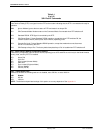
AT Commands and S-Registers
4-33821-A2-GB20-30 February 1998
Table 4-1
(1 of 13)
3821
Plus
AT Commands
*** – AT Command Recovery Mode
Allows the modem to remain in Asynchronous data mode so that AT commands can be used to change the modem’s
current configuration. Use this command when AT commands are disabled or the modem is operating in Synchronous
data mode.
This command can only be executed after the completion of a power-up self-test. Refer to
Recovering AT Commands
later in this chapter for procedures and guidelines on this command.
A/ – Repeat Last Command
Reexecutes the last command string. (Not to be preceded with AT or followed by pressing the Enter key.)
A – Answer Mode
Allows the modem to go off-hook and attempts to establish a connection without waiting for a ring.
B – ITU-T/Bell Mode
Determines the protocol used if the dial-line rate is set to 300 or 1200 bps. It has no effect if the rate is set to another
value. (See %B.)
B, B0 V.21 or V.22 (300 or 1200 bps)
B1 Bell 103 or Bell 212A (300 or 1200 bps)
D
n
– Dial
Begins the dialing sequence. The dial string
n
(modifiers and telephone number) is entered after the D command.
Any digit 0–9, * , # , A, B, C, D, may be dialed as a DTMF tone. Only the digits 0–9 can be dialed in Pulse Dial mode.
The following example shows how to dial through a PBX. The dial string consists of the command string and the
telephone number:
ATDT9,5551234
Command Telephone
String Number
Dial String
Modifiers include the following parameters:
T – Tone (DTMF) dial. Any digit 0–9, * , # , A, B, C, or D can be dialed as tone.
P – Pulse dial. Only the digits 0–9 can be dialed in Pulse Dial mode.
NOTE: Once a dialing method (tone or pulse) has been specified, it will remain active only until the end of that dial string.
The factory setting is Tone dial.
, – Pause. Causes the modem to pause before processing the next character in the dial string. The length of this pause is
determined by the value held in S-register S8, the Pause Time configuration option.
W – Wait for dial tone. Modem waits for a second dial tone before processing the dial string. This can be the initial dial
tone or a second tone received when dialing through a tandem PBX (for example, 9W555-6789), or when invoking
special features (for example, 70#W555-6789, where 70# is the local telephone company command that disables Call
Waiting).


















